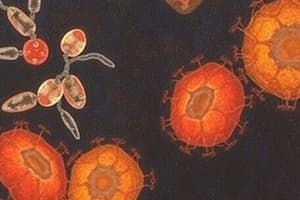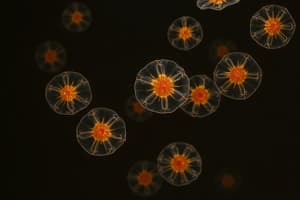Podcast
Questions and Answers
Explain the fundamental difference between B-cell receptors (BCRs) and T-cell receptors (TCRs) in terms of their antigen recognition mechanisms. Emphasize the structural differences that contribute to this distinction.
Explain the fundamental difference between B-cell receptors (BCRs) and T-cell receptors (TCRs) in terms of their antigen recognition mechanisms. Emphasize the structural differences that contribute to this distinction.
BCRs recognize a wide variety of antigens, including carbohydrates, lipids, DNA, and proteins, directly. They have two antigen-binding sites formed by the pairing of heavy and light chains. In contrast, TCRs only recognize peptide antigens presented by cells in complex with MHC molecules. TCRs have a single binding site formed by the alpha and beta chains. This difference reflects the distinct roles of B cells and T cells in the immune response.
Describe the process of clonal selection in B-cell activation. How does this process contribute to the generation of a diverse antibody repertoire?
Describe the process of clonal selection in B-cell activation. How does this process contribute to the generation of a diverse antibody repertoire?
When an antigen enters the lymph nodes, it encounters naive B cells with diverse BCRs. Clonal selection occurs when a specific B cell with a BCR that recognizes the antigen is activated. This activated B cell undergoes rapid replication, producing clones of itself. These clones differentiate into plasma cells, which secrete large quantities of antibodies specific to that antigen, and memory cells, which provide long-term immunity. Clonal selection ensures that only B cells specific to a particular antigen are activated and amplified, leading to a highly targeted immune response and a diverse antibody repertoire.
Explain the roles of plasma cells and memory B cells in providing long-term immunity. How do these cell types contribute to a faster and more effective response to subsequent infections with the same pathogen?
Explain the roles of plasma cells and memory B cells in providing long-term immunity. How do these cell types contribute to a faster and more effective response to subsequent infections with the same pathogen?
Plasma cells are short-lived cells that secrete large quantities of antibodies, providing immediate protection against an ongoing infection. Memory B cells are long-lived cells that retain the same BCR as the activated parent B cell. Upon re-exposure to the same antigen, memory B cells rapidly differentiate into plasma cells, producing a large number of antibodies, leading to a faster and more effective response, often preventing disease symptoms. This provides long-term immunity against pathogens that are encountered previously.
Explain how vaccines work in the context of clonal selection and memory B cell formation. Describe the specific mechanisms involved in the generation of protective immunity through vaccination.
Explain how vaccines work in the context of clonal selection and memory B cell formation. Describe the specific mechanisms involved in the generation of protective immunity through vaccination.
Signup and view all the answers
Compare and contrast the mechanisms by which B cells and T cells contribute to immune responses. Explain how their distinct roles contribute to a coordinated and effective defense against pathogens.
Compare and contrast the mechanisms by which B cells and T cells contribute to immune responses. Explain how their distinct roles contribute to a coordinated and effective defense against pathogens.
Signup and view all the answers
Describe the process by which a B cell develops its unique antibody specificity, emphasizing the role of genetic recombination.
Describe the process by which a B cell develops its unique antibody specificity, emphasizing the role of genetic recombination.
Signup and view all the answers
Explain how the adaptive immune system remembers past exposures to pathogens, highlighting the role of memory B cells.
Explain how the adaptive immune system remembers past exposures to pathogens, highlighting the role of memory B cells.
Signup and view all the answers
What are the two main arms of the adaptive immune response and how do they differ in their mechanisms of action?
What are the two main arms of the adaptive immune response and how do they differ in their mechanisms of action?
Signup and view all the answers
Explain the role of dendritic cells in initiating the adaptive immune response, highlighting their unique features and functions.
Explain the role of dendritic cells in initiating the adaptive immune response, highlighting their unique features and functions.
Signup and view all the answers
Describe the process of antibody affinity maturation, emphasizing its role in enhancing the effectiveness of the immune response.
Describe the process of antibody affinity maturation, emphasizing its role in enhancing the effectiveness of the immune response.
Signup and view all the answers
Explain the difference between a naive B cell and an activated B cell, highlighting the key changes that occur upon activation.
Explain the difference between a naive B cell and an activated B cell, highlighting the key changes that occur upon activation.
Signup and view all the answers
How does the lymphatic system contribute to the adaptive immune response, specifically in the context of antigen presentation?
How does the lymphatic system contribute to the adaptive immune response, specifically in the context of antigen presentation?
Signup and view all the answers
Flashcards
B cells
B cells
White blood cells produced in the bone marrow that create antibodies.
Antibody Diversity
Antibody Diversity
The variety of antibodies generated through genetic recombination of V, J, and D segments.
V region
V region
Variable region of an antibody that differs among different antibodies.
Somaatic hypermutations
Somaatic hypermutations
Signup and view all the flashcards
Adaptive immunity
Adaptive immunity
Signup and view all the flashcards
Dendritic cells
Dendritic cells
Signup and view all the flashcards
Lymphatic system
Lymphatic system
Signup and view all the flashcards
Humoral response
Humoral response
Signup and view all the flashcards
B-cell Receptor (BCR)
B-cell Receptor (BCR)
Signup and view all the flashcards
Clonal selection
Clonal selection
Signup and view all the flashcards
Memory B-cells
Memory B-cells
Signup and view all the flashcards
Study Notes
Antibody Production and Adaptive Immunity
- Antibodies are produced by B cells, which originate in bone marrow.
- Each B cell clone produces a unique antibody type.
- IgD antibodies act as B cell receptors (BCRs).
- Antibodies have variable regions (V) that differ between antibodies, and constant regions (C) that remain the same.
- Adaptive immunity is not inherited, it's created de novo (newly).
- B cells differentiate and produce unique antibodies by rearranging antibody genes.
- Antibody genes are found in segments on chromosomes, including:
- 30-45 variable (V) gene segments
- Variable and constant gene segments
- Several joining (J) gene segments
- Heavy chain has several diversity (D) gene segments.
- Each B cell clone has a unique variable region for its light and heavy chains.
- Antibody diversity is generated through:
- Combinatorial diversity: genetic recombination between V, J, and D segments (heavy) and V and J segments (light).
- Junctional diversity: random mutations at the junctions of the gene segments.
- Somatic hypermutations: continuous mutations in the variable region of an antibody.
- B cell activation: binding an antigen triggers massive proliferation of the matching B cell clone.
- Antibodies have secreted forms for adaptive immune response.
- In lymph nodes, B cells make more mutations in the variable region to increase antibody affinity.
Adaptive Immune System
- The adaptive immune system creates immunological memory.
- Vaccines rely on this memory to prevent disease.
- Memory is controlled by B cells and T cells (lymphocytes).
- Two main types of adaptive responses:
- Humoral response: antibody-mediated immunity.
- Cell-mediated response: involves the direct action of T cells.
- Immune responses are initiated when damage occurs and involve multiple cell types:
- Macrophages, neutrophils, and complement proteins assist.
- Dendritic cells (DCs) are crucial antigen-presenting cells (APCs).
- Dendritic cells reside in epithelial tissues (external-facing tissues).
- Their long cytoplasmic extensions (dendrites) and pathogen recognition receptors (PRRs) help capture antigens.
- When exposed to microbes and cytokines, DCs activate, migrate to lymph nodes and present the antigens.
- Lymphatic system and lymph nodes are essential for antigen presentation.
- Lymph fluid movement is driven by muscle contractions.
- Antigens presented in lymph nodes(soluble antigens in the bloodstream are presented in the spleen).
- Antigen presentation pathway:
- External barriers are breached, microbes enter the body.
- Dendritic cells engulf and display the antigens.
- Antigens are presented in lymph nodes (or spleen for soluble antigens).
- Naive B cells bind to the antigen and become activated.
- Native T cells bind to the antigen and become activated.
Lymphocytes (B cells and T cells)
- B cells produce and secrete antibodies (humoral immunity).
- B cells mature in bone marrow.
- T cells detect and kill infected cells (cell-mediated immunity).
- T cells mature in the thymus.
- Both originate from stem cells in bone marrow and migrate to lymph nodes.
- Each B and T cell is defined by its unique receptors.
B Cell Receptor (BCR)
- BCR is composed of four chains: two heavy and two light chains.
- A pair of light and heavy chains creates an antigen binding site.
- Chains are connected by disulfide bridges.
- Antigen-binding sites are located in the variable region.
- BCRs are membrane-bound antibodies (IgD).
- BCRs recognize various antigens (carbohydrates, lipids, DNA, proteins).
T Cell Receptor (TCR)
- TCR has only one binding site.
- Recognizes peptide antigens presented by other cells.
- TCRs are made using similar gene arrangements as antibodies.
- TCR is composed of two chains: alpha and beta chains connected by a disulfide bridge.
B Cell Activation, Clonal Selection, and Antibody Secretion
- B cell activation occurs when antigens are delivered to the lymph nodes.
- A B cell's BCR recognizes a specific antigen.
- Antigen binding activates the B cell, initiating rapid replication (clonal expansion).
- Activated B cells differentiate into plasma cells or memory cells.
- Plasma cells secrete large amounts of antibodies (5-6 days after infection).
- Some mature plasma cells remain in bone marrow, producing low-level antibodies.
- Memory B cells have the same membrane-bound antibody as the activated parent B cell.
- Memory B cells provide long-lasting immunity and respond very quickly to subsequent encounters with the same antigen, minimizing or eliminating symptoms.
- Vaccines work by introducing antigens to stimulate the immune system to make antibodies including memory cells. These memory cells provide immunity when exposed to the actual pathogen later.
Studying That Suits You
Use AI to generate personalized quizzes and flashcards to suit your learning preferences.
Description
This quiz explores the mechanisms of antibody production by B cells and the principles of adaptive immunity. Learn about the unique structures of antibodies, gene rearrangement, and how B cells contribute to immune diversity. Perfect for students studying immunology or related fields.
![Lecture 05: Antibody Production and Adaptive Immunity [SEQ 2]](https://assets.quizgecko.com/cdn-cgi/image/width=800,height=300,fit=crop,quality=75,format=webp/quiz/f58dc4dbf6c4223e9570af009a23110d.jpg)



![Lecture 05: Antibody Production and Adaptive Immunity [MCQ 1]](https://images.unsplash.com/photo-1591185157258-11aec5f039d0?crop=entropy&cs=srgb&fm=jpg&ixid=M3w0MjA4MDF8MHwxfHNlYXJjaHw0fHxhbnRpYm9keSUyMHByb2R1Y3Rpb24lMkMlMjBhZGFwdGl2ZSUyMGltbXVuaXR5JTJDJTIwaW1tdW5lJTIwc3lzdGVtJTJDJTIwYmlvbG9neXxlbnwxfDB8fHwxNzM4NzMyMDgxfDA&ixlib=rb-4.0.3&q=85&w=300&fit=crop&h=200&q=75&fm=webp)